As we step into the world of leopard gecko lighting, we embark on a journey to uncover the hidden secrets that will illuminate the lives of these captivating creatures. With each flicker of light, we have the power to enhance their well-being and unlock the true potential of their vibrant colors and unique behaviors.
But the path to perfect lighting is not without its challenges, as we must navigate through a myriad of options and considerations. Join us as we explore the intricacies of temperature requirements, the different types of lighting available, and the art of creating a comfortable and stimulating environment for our leopard geckos.
Prepare yourself for a captivating adventure that will shed light on the mysteries of these enchanting creatures.
Key Takeaways
- Leopard geckos require specific lighting requirements including a clear heat bulb for daylight, UVB fixture with a 5-6% bulb, and a ceramic heat emitter bulb or heating pad for nighttime heating.
- It is important to maintain the proper temperature gradient for leopard geckos, with a basking spot temperature of 88-92°F, daytime air temperature of 80-83°F, and cool side temperature of 70-76°F.
- Daytime lighting should mimic the Middle East day/night cycle, with 14 hours of daytime in summer and 12 hours of daytime in winter. Gradually adjust intervals by 15-30 minutes per week and use a timer for convenience and safety.
- Relying on natural light from windows may not provide the necessary lighting and temperature control for leopard geckos. It is recommended to use specialized lighting and heat sources for consistency and to avoid overheating.
Lighting Requirements for Leopard Geckos

When it comes to meeting the lighting requirements for leopard geckos, a combination of different types of light sources is necessary to ensure their well-being and mimic their natural habitat. A proper lighting setup includes an incandescent clear heat bulb for daylight, a T8 to T5 UVB fixture with a 5-6% bulb, a ceramic heat emitter bulb or heating pad for nighttime heating, and an optional red, blue, or black light for observation.
A lighting schedule that mimics the Middle East day/night cycle is recommended, with 14 hours of daytime and 10 hours of nighttime during summer, and 12 hours of daytime and 12 hours of nighttime during winter. It's important to gradually adjust the intervals by 15-30 minutes per week and use a timer for convenience and safety.
Temperature Requirements for Leopard Geckos
To ensure the optimal conditions for leopard geckos, it's crucial to understand and meet their temperature requirements. Leopard geckos are ectothermic reptiles, meaning they rely on external heat sources to regulate their body temperature.
The basking spot temperature should be maintained at 88-92°F, while the daytime air temperature should be around 80-83°F. On the cool side, the temperature should range from 70-76°F. Achieving these temperature ranges can be accomplished through various gecko heating methods, such as using an under tank heater to create a temperature gradient.
It's essential to maintain these optimal temperatures to ensure the gecko's well-being and promote proper digestion, activity, and overall health. Regular monitoring of temperature levels and the use of thermostats are necessary to provide a consistent and comfortable environment for leopard geckos.
Daytime Lighting for Leopard Geckos

Daytime lighting for leopard geckos involves providing the necessary illumination to mimic their natural day/night cycle in the Middle East, ensuring they receive the appropriate amount of light for their well-being. To achieve this, it's important to establish a temperature gradient within their enclosure. This allows leopard geckos to regulate their body temperature by moving between warmer and cooler areas. A temperature gradient is crucial for their physiological processes, including digestion and thermoregulation.
Using timers for leopard gecko lighting offers several benefits. They provide convenience by automating the lighting schedule, ensuring consistency and reducing the chances of human error. Timers also promote the geckos' natural day/night cycle by controlling the duration of light exposure. This helps to regulate their sleep patterns and overall behavior.
Additionally, timers enhance safety by eliminating the risk of accidentally leaving lights on for extended periods, which could disrupt the geckos' natural rhythm and potentially harm their well-being. Therefore, incorporating timers into the lighting setup is highly recommended for leopard geckos.
Using Natural Light for Leopard Geckos
Using natural light for leopard geckos provides several challenges and limitations that make it difficult to rely solely on this light source for their lighting needs. One of the main challenges is the issue of window lighting. When using natural light from windows, there are concerns about overheating and temperature control, as well as the fact that glass filters out usable UVB.
Additionally, the outside weather may not always mimic the native environment of leopard geckos. To ensure consistency in lighting, it's important to use our own lighting and heat sources. This allows us to have better control over the temperature and light cycles, ensuring that the leopard geckos receive the appropriate lighting they need for their well-being.
Types of Lighting for Leopard Geckos

There are several types of lighting options available for leopard geckos that provide the necessary visible light, heat, and UVB spectrum lighting they require for their overall health and well-being. These lighting options include incandescent bulbs for visible light and heat, UVB fluorescent tube fixtures, and mercury vapor lamps.
The table below provides a comparison of these lighting options:
| Lighting Option | Benefits of UVB | Additional Features |
|---|---|---|
| Incandescent bulbs | Limited UVB spectrum | Provides visible light and heat |
| UVB fluorescent tube fixtures | Effective UVB spectrum | Replace bulbs every 6 months |
| Mercury vapor lamps | Provides both UVA and UVB spectrum | Can replace incandescent bulbs and UVB fixtures |
| More cost-effective compared to | ||
| fluorescent tube fixtures |
It is important to note that leopard geckos need a 5-6% strength UVB bulb, and it is recommended to use reptile branded bulbs. These lighting options play a crucial role in providing the necessary lighting and heat for leopard geckos, ensuring their well-being and overall health.
Frequently Asked Questions
Can I Use a Regular Light Bulb as a Heat Source for My Leopard Gecko?
Yes, you can use a regular light bulb as a heat source for your leopard gecko, but it's not the best option. Alternative heat sources like ceramic heat emitters or heating pads are more suitable for maintaining proper temperature and preventing overheating.
How Often Should I Replace the UVB Bulb in My Leopard Gecko's Enclosure?
We replace the UVB bulb in our leopard gecko's enclosure every 6 months to ensure they receive the necessary UVB spectrum for their health. Regular replacement is crucial for their well-being and proper calcium absorption.
Is It Necessary to Use a Thermostat With the Ceramic Heat Emitter Bulb?
Using a thermostat with a ceramic heat emitter bulb is necessary for regulating temperature and preventing overheating. The benefits include maintaining a consistent and safe environment for the leopard gecko's well-being.
Can I Use a Regular Household Timer for My Leopard Gecko's Lighting Schedule?
Yes, we can use a regular household timer for our leopard gecko's lighting schedule. It is important to create a natural lighting cycle for our geckos, mimicking their native environment for their well-being.
What Is the Ideal Humidity Level for Leopard Geckos and How Can I Measure It Accurately?
The ideal humidity level for leopard geckos is 30-40%. Proper humidity is important for shedding and respiratory health. Accurately measure humidity with a hygrometer. Maintaining temperature and humidity is crucial for the well-being of leopard geckos.
Conclusion
In conclusion, the secrets to perfect leopard gecko lighting lie in understanding their specific lighting and temperature needs. By providing the right type of lighting and maintaining a proper temperature gradient, we can create a comfortable and stimulating environment for our geckos.
Just as a well-lit stage enhances a performer's performance, the right lighting for leopard geckos enhances their health and well-being. So, let's unlock these secrets and watch our geckos thrive in their new lighting setup, like stars shining brightly on a stage.

